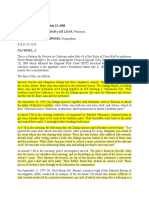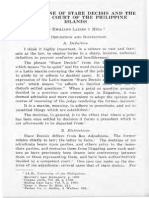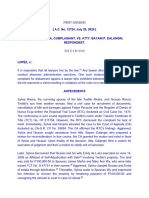100%(1)100% found this document useful (1 vote)
62 viewsEnglish For The Bar
English For The Bar
Uploaded by
Jasper PogiThe document provides tips for answering questions on the English for the Bar exam, including using transitional devices, avoiding words like "irregardless", properly referring to contracts and courts, emphasizing jurisprudence and applying it to the case, and citing laws and the constitution. It also notes keywords for discussing the purpose and intent of laws and jurisdiction.
Copyright:
© All Rights Reserved
Available Formats
Download as DOCX, PDF, TXT or read online from Scribd
English For The Bar
English For The Bar
Uploaded by
Jasper Pogi100%(1)100% found this document useful (1 vote)
62 views18 pagesThe document provides tips for answering questions on the English for the Bar exam, including using transitional devices, avoiding words like "irregardless", properly referring to contracts and courts, emphasizing jurisprudence and applying it to the case, and citing laws and the constitution. It also notes keywords for discussing the purpose and intent of laws and jurisdiction.
Original Title
English for the Bar
Copyright
© © All Rights Reserved
Available Formats
DOCX, PDF, TXT or read online from Scribd
Share this document
Did you find this document useful?
Is this content inappropriate?
The document provides tips for answering questions on the English for the Bar exam, including using transitional devices, avoiding words like "irregardless", properly referring to contracts and courts, emphasizing jurisprudence and applying it to the case, and citing laws and the constitution. It also notes keywords for discussing the purpose and intent of laws and jurisdiction.
Copyright:
© All Rights Reserved
Available Formats
Download as DOCX, PDF, TXT or read online from Scribd
Download as docx, pdf, or txt
100%(1)100% found this document useful (1 vote)
62 views18 pagesEnglish For The Bar
English For The Bar
Uploaded by
Jasper PogiThe document provides tips for answering questions on the English for the Bar exam, including using transitional devices, avoiding words like "irregardless", properly referring to contracts and courts, emphasizing jurisprudence and applying it to the case, and citing laws and the constitution. It also notes keywords for discussing the purpose and intent of laws and jurisdiction.
Copyright:
© All Rights Reserved
Available Formats
Download as DOCX, PDF, TXT or read online from Scribd
Download as docx, pdf, or txt
You are on page 1of 18
Notes: English for the Bar lecture by Atty.
Santiago-Leynes
1. Use transitional devices or discourse markers. I.e.
2. “Advice” ay noun. “Advise” ay verb. Pagmagsasagot “I will advise my client to…”
3. Do not use “Irregardless”
4. A contract (or a notarial book) is “entered into”
5. Beware on the use of “On all fours”. It is an idiom that can be used in answering if the bar
problem is exactly the same. Use “similar” if the facts are merely just similar.
6. Do not use generic terms such as law. Use “Civil Law” “Labor Law”, etc.
7. If the answer is too long, it is best to separate different thoughts.
8. “The Court” has (kase singular ang Court)
9. Reasons behind the law keywords – “The purpose of the law is” “The law is designed to” “It is
intended to shield”
10. Jurisdiction – “The case is beyond the ambit of the jurisdiction of the…” “It is within the ambit of
the…”
11. Emphasizing Case Doctrines/Jurisprudence – “Elementary is the rule that…” “It is hornbook
doctrine in (i.e. Civil Law) that…” “The cardinal rule in (i.e. labor law) is that…”
12. Referring back to the case – “Applying the said law/doctrine in the instant case…”
13. Concluding Words – “Taken all together…” “Finally” “Hence” “As a necessary consequence”
Lexical Bundles
Citing Law – “No less than the 1987 Constitution provides for the…” “According to the…”
Flow
You might also like
- War crimes and crimes against humanity in the Rome Statute of the International Criminal CourtFrom EverandWar crimes and crimes against humanity in the Rome Statute of the International Criminal CourtNo ratings yet
- From Philippine Jurisprudence Official Page: Reason/S Behind The LawDocument11 pagesFrom Philippine Jurisprudence Official Page: Reason/S Behind The LawPatrick Dag-um MacalolotNo ratings yet
- LegalEthicsDigest - Cordova Vs Labayen, AM RTJ-93-1033 (Oct. 10, 1995)Document1 pageLegalEthicsDigest - Cordova Vs Labayen, AM RTJ-93-1033 (Oct. 10, 1995)Lu CasNo ratings yet
- Atty Ligon Tx2Document92 pagesAtty Ligon Tx2karlNo ratings yet
- Crimpro Finals Reviewer 2 PDFDocument38 pagesCrimpro Finals Reviewer 2 PDFRussell Stanley Que GeronimoNo ratings yet
- Tan Vs BantigueDocument3 pagesTan Vs BantigueSynnove BagalayNo ratings yet
- Heirs of Marcelo Sotto vs. PalicteDocument2 pagesHeirs of Marcelo Sotto vs. Palictedar080No ratings yet
- 2011 Remedial Law - Dean RianoDocument179 pages2011 Remedial Law - Dean RianoA-em Jaime AlbertusNo ratings yet
- Remedial Law Notes 2Document14 pagesRemedial Law Notes 2JoAnneGallowayNo ratings yet
- Civil Law Last Minute Tips FEUDocument18 pagesCivil Law Last Minute Tips FEUKaren SupapoNo ratings yet
- Rule 19.03 CPRDocument3 pagesRule 19.03 CPRJesus Inno LoretoNo ratings yet
- SEC 15.01 - Calme V CA, GR No. 116688, 261 SCRA 285 PDFDocument7 pagesSEC 15.01 - Calme V CA, GR No. 116688, 261 SCRA 285 PDFabo8008No ratings yet
- CIVIL LAW Atty. Rachelle CastroDocument130 pagesCIVIL LAW Atty. Rachelle CastroAliah Ceralde100% (1)
- LegCoun InterviewDocument4 pagesLegCoun InterviewJohansen FerrerNo ratings yet
- Canon 1-3 P2Document104 pagesCanon 1-3 P2Glace OngcoyNo ratings yet
- Evidence Assignment 1-18 3 and 7 Not IncludedDocument143 pagesEvidence Assignment 1-18 3 and 7 Not IncludedJC HilarioNo ratings yet
- What Is Legal CounselingDocument2 pagesWhat Is Legal CounselingPaolo Sison GoNo ratings yet
- Globe Mackay Cable and Radio Corp., and Herbert C. Hendry v. The HonorableDocument1 pageGlobe Mackay Cable and Radio Corp., and Herbert C. Hendry v. The HonorableMINORKASUSHMITA PATAUNIANo ratings yet
- Cerilla V LezamaDocument1 pageCerilla V LezamaChristian Delos ReyesNo ratings yet
- De Agbayani v. PNBDocument12 pagesDe Agbayani v. PNBJohn Rey FerarenNo ratings yet
- Phi LawDocument3 pagesPhi LawJonh Nichole AvelinoNo ratings yet
- Torts Law Summary - SampleDocument16 pagesTorts Law Summary - SamplejiroNo ratings yet
- Conflict of Laws - Wills and SuccessionDocument5 pagesConflict of Laws - Wills and SuccessionTrixie Jane NeriNo ratings yet
- 02 - Lorenzana vs. FajardoDocument5 pages02 - Lorenzana vs. Fajardoanajuanito100% (1)
- PLJ Volume 16 Number 9 - 02 - Emiliano Lazaro Y Mina-The Doctrine of Stare Decisis and The Supreme Court of The Philippine IslandsDocument16 pagesPLJ Volume 16 Number 9 - 02 - Emiliano Lazaro Y Mina-The Doctrine of Stare Decisis and The Supreme Court of The Philippine Islandscamille6navarroNo ratings yet
- Affidavit EngDocument1 pageAffidavit EngkadospotifyoneNo ratings yet
- 16 Rivera v. Atty. Dalangin, A.C. No. 12724, July 28, 2020Document9 pages16 Rivera v. Atty. Dalangin, A.C. No. 12724, July 28, 2020Lex LawNo ratings yet
- Legal EthicsDocument4 pagesLegal EthicsJosh PascuaNo ratings yet
- Acknowledgment of Nominee Status With AssignmentDocument2 pagesAcknowledgment of Nominee Status With AssignmentGodofredo Sabado100% (1)
- Political Law and Public International Law Must Read CasesDocument45 pagesPolitical Law and Public International Law Must Read CasesCrest PedrosaNo ratings yet
- Canon 15 CasesDocument8 pagesCanon 15 CasesIanNo ratings yet
- Doctrines: Civil Law of The PhilippinesDocument157 pagesDoctrines: Civil Law of The PhilippinesGABRONINO CATHERINENo ratings yet
- Legal Forms CasesDocument68 pagesLegal Forms CasesNori LolaNo ratings yet
- 15 Complaint in Form of Class SuitDocument1 page15 Complaint in Form of Class SuitNikki Joanne Armecin LimNo ratings yet
- Civ - de Los Angeles - LTD 5Document8 pagesCiv - de Los Angeles - LTD 5Lirio IringanNo ratings yet
- RULE 139-B AmendmentDocument4 pagesRULE 139-B AmendmentKarla Marie TumulakNo ratings yet
- Written Pleadings (FINAL DRAFT)Document14 pagesWritten Pleadings (FINAL DRAFT)Devon Jerameel MaruNo ratings yet
- Rule 4. Venue: Kind of Problem Could Be Given in The Midterm Exam)Document6 pagesRule 4. Venue: Kind of Problem Could Be Given in The Midterm Exam)Marion JossetteNo ratings yet
- Conflicts of Law - NotesDocument4 pagesConflicts of Law - NotesAnie Guiling-Hadji Gaffar100% (1)
- Grassroots Practice Court: Legal Counseling Friday 5:30-7:30pm Group 6Document5 pagesGrassroots Practice Court: Legal Counseling Friday 5:30-7:30pm Group 6mifajNo ratings yet
- Case DoctrinesDocument8 pagesCase DoctrinesCharles RiveraNo ratings yet
- Automatic Conversion RuleDocument1 pageAutomatic Conversion RuleRusty NomadNo ratings yet
- DBM Vs MAnila's FinestDocument6 pagesDBM Vs MAnila's FinestVince Llamazares LupangoNo ratings yet
- Villarin vs. Atty. SabateDocument2 pagesVillarin vs. Atty. SabateLloyd David P. VicedoNo ratings yet
- PLJ Volume 1 Number 1 - 04 - Jose A. Espiritu - Parts of The Code of Commerce PDFDocument21 pagesPLJ Volume 1 Number 1 - 04 - Jose A. Espiritu - Parts of The Code of Commerce PDFiammaan214No ratings yet
- 35 Philippine Dream Company Inc. V.20210424-12-1jxqs4iDocument11 pages35 Philippine Dream Company Inc. V.20210424-12-1jxqs4iervingabralagbonNo ratings yet
- Suggested Answers To The Bar Exam Questions 2008 On Political LawDocument1 pageSuggested Answers To The Bar Exam Questions 2008 On Political LawLepelynSarausValdezNo ratings yet
- Requirement For Provisional RemedyDocument5 pagesRequirement For Provisional RemedyEdsel Ian S. FuentesNo ratings yet
- 2 CIV NotesDocument4 pages2 CIV NotesChic PabalanNo ratings yet
- Tax 2 Syllabus - DDL - 2019 PartA 11jan2019Document7 pagesTax 2 Syllabus - DDL - 2019 PartA 11jan2019ebernardo19No ratings yet
- Evidence Case DigestDocument19 pagesEvidence Case DigestWeng CuevillasNo ratings yet
- Legal Counselling Ad Social Responsibility PDFDocument45 pagesLegal Counselling Ad Social Responsibility PDFbenjocalvaryahoocomNo ratings yet
- FQ 4Document21 pagesFQ 4Audrey Kristina MaypaNo ratings yet
- CrimDocument6 pagesCrimMarinel June PalerNo ratings yet
- Special Proceedings Paredes Notes Case Law Compiled by FASDocument17 pagesSpecial Proceedings Paredes Notes Case Law Compiled by FASKarla Marie TumulakNo ratings yet
- Feliciano, Luigi MarvicDocument55 pagesFeliciano, Luigi MarvicLuigi Feliciano100% (1)
- Case BriefDocument4 pagesCase BriefGoldamier Indardaya - MamutukNo ratings yet
- Case Digest VII Legal EthicsDocument30 pagesCase Digest VII Legal EthicsSushmita Shane CastroNo ratings yet
- Law Firm Strategies for the 21st Century: Strategies for Success, Second EditionFrom EverandLaw Firm Strategies for the 21st Century: Strategies for Success, Second EditionChristoph H VaagtNo ratings yet
- Tilted Justice: First Came the Flood, Then Came the Lawyers.From EverandTilted Justice: First Came the Flood, Then Came the Lawyers.Rating: 5 out of 5 stars5/5 (1)
- Pet 005Document3 pagesPet 005Jasper PogiNo ratings yet
- Legal Opinion On BaumgardnerDocument2 pagesLegal Opinion On BaumgardnerJasper PogiNo ratings yet
- Annex C - Deed of AssignmentDocument4 pagesAnnex C - Deed of AssignmentJasper PogiNo ratings yet
- Code of Professional Responsibility (Promulgated June 21, 1988) Chapter I. The Lawyer and SocietyDocument2 pagesCode of Professional Responsibility (Promulgated June 21, 1988) Chapter I. The Lawyer and SocietyJasper PogiNo ratings yet
- LABOR FINALS June 2022Document4 pagesLABOR FINALS June 2022Jasper PogiNo ratings yet
































































